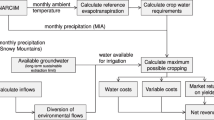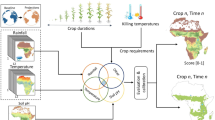Abstract
Paddy rice fields in Asia account for over 90% of global total rice cultivation area, and the major rice-producing countries of Asia account for over one-half of the world’s population. Monitoring and understanding the dynamic changes in paddy rice agriculture in Asia are very important for agricultural sustainability, food and water security, and greenhouse gas emissions. This paper presents a crop choice decision model that dynamically simulates future changes in sown areas of paddy rice in Asia. This model was developed under the framework of Action-in-Context (AiC) with the aim of understanding land users’ decisions on crop choices among a set of available alternatives using a crop utility function. Empirical validation for the model conducted after model construction indicated the reliability of the model for addressing the complexity of current agricultural land-use change and its capacity for investigating long-term scenarios in the future. Finally, the model was applied for future scenario analysis over a time frame of 30 years with 5-year increments, beginning from the year 2005. The simulation results provided insights into rates and trajectories of changes in Asian rice areas over the test period, with the resulting implications for future agricultural sustainability in Asia. These outcomes can improve understanding of projected land-use changes and explain their causes, locations and consequences, as well as providing support for land-use planning and policy making.







Similar content being viewed by others
References
Brown ME, Funk CC (2008) Food security under climate change. Science 319:580–581
Dawe D, Frolking S, Li C (2004) Trends in rice–wheat area in China. Field Crops Res 87:89–95
Döll P, Siebert S (2000) A digital global map of irrigated areas. ICID J 49:55–66
Ericksen PJ (2008) Conceptualizing food systems for global environmental change research. Global Environ Change 18:234–245
Frolking S, Qiu J, Boles S, Xiao X, Liu J, Zhuang Y, Li C, Qin X (2002) Combining remote sensing and ground census data to develop new maps of the distribution of rice agriculture in China. Glob Biogeochem Cycles 16(4):1091, doi:10.1029/2001GB001425
Frolking S, Yeluripati JB, Ellen Douglas E (2006) New district-level maps of rice cropping in India: a foundation for scientific input into policy assessment. Field Crops Res 98:164–177
Gregory PJ, Ingram JSI, Brklacich M (2005) Climate change and food security. Philos Trans R Soc B 360:2139–2148
Howden SM, Soussan JF, Tubiello FN, Chhetri N, Dunlop M, Meinke H (2007) Adapting agriculture to climate change. Proc Natl Acad Sci USA 104:19691–19696
IPCC (2007) Climate change 2007: the physical science basis, contribution of Working Group I to the fourth assessment report of the Intergovernmental Panel on climate change. Cambridge University Press, Cambridge
Kamthonkiat D, Honda K, Turral H, Tripathi NK, Wuwongse V (2005) Discrimination of irrigated and rainfed rice in a tropical agricultural system using SPOT VEGETATION NDVI and rainfall data. Int J Remote Sens 26:2527–2547
Leff B, Ramankutty N, Foley JA (2004) Geographic distribution of major crops across the world. Glob Biogeochem Cycles 18 GB1009. doi:10.1029/2003GB002108
Li C, Frolking S, Xiao X, Moore B, Boles S, Qiu J, Huang Y, Salas W, Sass R (2005) Modeling impacts of farming management alternatives on CO2, CH4, and N2O emissions: a case study for water management of rice agriculture in China. Glob Biogeochem Cycles 19:GB3010. doi:10.1029/2004GB002341
Lin GCS, Ho SPS (2003) China’s land resources and land-use change: insights from the 1996 land survey. Land Use Policy 20:87–107
Lobell DB, Burke MB, Tebaldi C, Mastrandrea MD, Falcon WP, Naylor RL (2008) Prioritizing climate change adaptation needs for food security in 2030. Science 319:604–610
Maclean J, Dawe D, Hardy B, Hattel G (eds) (2002) Rice almanac: source book for the most important crop on Earth. CABI, Oxon
McFadden D (1973) Conditional logit analysis of qualitative choice behaviour. In: Zakembka P (ed) Frontiers in econometrics. Academic, New York
Monfred C, Ramankutty N, Foley JA (2008) Farming the planet: 2. Geographic distribution of crop areas, yields, physiological types, and net primary production in the year 2000. Glob Biogeochem Cycles 22:GB1022. doi:10.1029/2007GB002947
Ohga K, Gehlar C (1993) The international food policy simulation (IFPSIM) model: a documentation and application. IFPRI, Washington DC
Ohga K, Yanagishima K (1996) JIRCAS working report No. 1: international food and agricultural policy simulation model. Japan International Research Center for Agricultural Sciences (JIRCAS) Ministry of Agriculture, Forestry and Fisheries
Overmars KP, De Groot WT, Huigen MGA (2007a) Comparing inductive and deductive modeling of land use decisions: priciples, a model and an illustration from the Philippines. Hum Ecol 35:439–452
Overmars KP, Verburg PH, Veldkamp A (2007b) Comparison of a deductive and an inductive approach to specify land suitability in a spatially explicit land use model. Land Use Policy 24:584–599
Pollock C, Pretty J, Crute I, Leaver C, Dalton H (2008) Introduction sustainable agriculture. Philos Trans R Soc B 363:445–446
Pretty J (2008) Agricultural sustainability: concepts, principles and evidence. Philos Trans R Soc B 363:447–465
Rounsevell MDA, Ewert F, Reginster I, Leemans R, Carter TR (2005) Future scenarios of European agricultural land use II. Projecting changes in cropland and grassland. Agric Ecosyst Environ 107:117–135
Rounsevell MDA, Reginster I, Araujo MB, Carter TR, Dendoncker N, Ewert F, House JI, Kankaanpaa S, Leemans R, Metzger MJ, Schmit C, Smith P, Tuck G (2006) A coherent set of future land use change scenarios for Europe. Agric Ecosyst Environ 114:57–68
Schmidhuber J, Tubiello FN (2007) Global food security under climate change. Proc Natl Acad Sci USA 104:19703–19708
Seo SN, Mendelsohn R (2008) An analysis of crop choice: adapting to climate change in South American farms. Ecol Econ 67:109–116. doi:10.1016/j.ecolecon.2007.12.007
Serneels S, Lambin EF (2001) Proximate causes of land use change in Narok district Kenya: a spatial statistical model. Agric Ecosyst Environ 85:65–81
Shao Y, Fan X, Liu H, Xiao J, Ross S, Brisco B, Brown R, Staples G (2001) Rice monitoring and production estimation using multitemporal RADARSAT. Remote Sens Environ 76:310–325
Tan G, Shibasaki R (2003) Global estimation of crop productivity and the impacts of global warming by GIS and EPIC integration. Ecol Model 168:357–370
Van Meijl H, van Rheenen T, Tabeau A, Eickhout B (2006) The impact of different policy environments on agricultural land use in Europe. Agric Ecosyst Environ 114:21–38
Verburg PH, Soepboer W, Limpiada R, Espaldon V, Mastura SSA (2002) Modeling the spatial dynamics of regional land use: the CLUE-S model. Environ Manage 30:391–405
Verburg PH, Veldkamp A, Rounsevell MDA (2006) Scenario-based studies of future land use in Europe. Agric Ecosyst Environ 114:1–6
Wang X, Bennett J, Xie C, Zhang Z, Liang D (2007) Estimating non-market environmental benefits of the conversion of cropland to forest and grassland program: a choice modeling approach. Ecol Econ 63:114–125
Williams JR, Jones CA, Kiniry JR, Spanel DA (1989) The EPIC crop growth model. Trans ASAE 32:497–511
Wu W, Shibasaki R, Yang P, Tan G, Matsumura K, Sugimoto K (2007a) Global-scale modelling of future changes in sown areas of major crops. Ecol Modell 208:378–390
Wu W, Shibasaki R, Yang P, Matsumura K, Sugimoto K (2007b) From process to pattern in LUCC—an agent-based model of agricultural land use change by coupling with GIS. In: Proceedings of the 28th Asian Conference on Remote Sensing, Kuala Lumpur, Malaysia
Wu W, Yang P, Meng C, Shibasaki R, Zhou Q, Tang H, Shi Y (2008) An integrated model to simulate sown area changes for major crops at a global scale. Sci China Ser D Earth Sci 51:370–379
Xiao X, Boles S, Liu J, Zhuang D, Frolking S, Li C, Salas W, Moore B III (2005) Mapping paddy rice agriculture in southern China using multi-temporal MODIS images. Remote Sens Environ 95:480–492
Xiao X, Boles S, Frolking S, Li C, Babu JY, Salas W, Moore B III (2006) Mapping paddy rice agriculture in South and Southeast Asia using multi-temporal MODIS images. Remote Sens Environ 100:95–113
You L, Wood S (2005) Assessing the spatial distribution of crop areas using a cross-entropy method. Int J Appl Earth Obs Geoinform 7:310–323
Zhao J, Luo Q, Deng H, Yan Y (2008) Opportunities and challenges of sustainable agricultural development in China. Philos Trans R Soc B 363:893–904
Acknowledgments
This study was supported financially by the Ministry of Education, Culture, Sports, Science and Technology of Japan under its DIAS (Data Integration and Analysis System) project, by National High Technology Research and Development Program of China (40930101 and 40971218), and by the Foundation for National Non-Profit Scientific Institution, Ministry of Finance of China (2009-IARRP-25). All persons and institutes who kindly made their data available for this analysis are acknowledged. Last but not least, we thank the anonymous reviewers for their constructive comments on an earlier version of the manuscript.
Author information
Authors and Affiliations
Corresponding author
Additional information
Edited by Mitsuru Osaki and Ademola Braimoh, Hokkaido University, Japan.
Rights and permissions
About this article
Cite this article
Wu, W., Shibasaki, R., Yang, P. et al. Modeling changes in paddy rice sown areas in Asia. Sustain Sci 5, 29–38 (2010). https://doi.org/10.1007/s11625-009-0094-0
Received:
Accepted:
Published:
Issue Date:
DOI: https://doi.org/10.1007/s11625-009-0094-0




